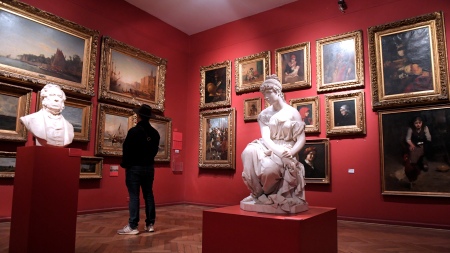The Night of the Museums, an event in which numerous cultural spaces open their doors for free, became a massive party that began at 7:00 p.m. with more than 270 venues that offered talks, workshops, music shows, screenings, and guided tours .
Despite the fact that Saturday night was a bit cold and somewhat windy, those who dared to visit the different museums prepared to line up and face the routes early. at 18 in the Museum of Fine Arts, the lanterns were already lit and an illuminated sign with a black background that said National Museums welcomed the public. Some bikes were already parked in the driveway. Although there was no queue at the entrance, all the rooms had more than five spectators just beginning the 18th edition of this cultural event that is already a classic.
Upon entering the museum, to the right, you could walk through a corridor whose axis is the importance of the image as a tool of power in Argentine art.

When Vanna and Ana arrive, they gasp in amazement. They are friends who participate for the first time in the Night of the Museums. “Two weeks ago we have prepared the itinerary. This is the first museum we visit. Then we go to the Jj Nahon in the Faculty of Medicine and from there to the Ana Frank Center,” says Ana, a native of the Tres de Febrero party in Buenos Aires.
“We like quiet plans, to travel, to Medicine we go because Ana studies medicine and to Anne Frank’s because we love it. We read the newspaper, we saw the movie and we are very interested in the Second World War,” Vanna said with emotion.
In the room that traces the beginnings of collecting in Argentina, there is the Guerrico collection and the scene that was repeated is that of visitors taking photos of the paintings or posing with the works behind their backs with their cell phones.
Iván, from Ecuador, is the second time he has visited the wall, also as part of The Night of the Museums. “He’s the only one I’m going to visit tonight. I love him. The most striking area for me is the one on the second floor, where there is a large stone mural.”
Photos: Julian Alvarez
In the building at Avenida Libertador 1473, “Carmelo Arden Quin, in the plot of constructive art”, “Last admissions” and “A celebration of Graciela Taquini” were displayed, the artist in whose work two registers converge simultaneously: a large amount of theory and a work of fantasy.
At 8 p.m., the institution proposed a tour for all ages through the works of artists such as León Ferrari, Emilio Pettoruti and Jackson Pollock with “the night” as the protagonist. At that time the lines to enter already lasted an hour.
As part of the “Behind the surface” cycle, every half hour until 10:30 p.m., there were guided tours with a gender perspective, dedicated to portraying the history of the women who are part of the museum’s collection. Also, activities will be offered in Argentine Sign Language (LSA), aimed at deaf and hard of hearing people.
Those who toured the facilities of the cultural institutions could take a bag with a pencil and a white notebook with the names of all the national museums on the back cover.
A family with these gifts from the Fine Arts in hand walked down Avenida Libertador to the Museum of Decorative Art. Already from the corner of Tagle Street, a long line could be seen from the entrance to almost the end of the block. From inside came the music of a blues that set the entrance to music.
“A family lived here, look,” a mother told her son as they entered the Great Hall, pointing to the exhibited furniture. The room shows different types of chairs, lamps and portable radios, it seeks to teach “objective democracy and consumer fetishes”. A Flemish tapestry called “the combat of Tessino” dresses one of the walls of the Great Hall. “That’s a tapestry,” a father explained to his son, who was gaping at him.
in the ballroomwhich evokes the years of the French Regency between 1705-1713 and which meant a period of transition between the solemnity of the Baroque and the harmonic grace of the Rococo, two friends posed with the golden walls behind them.
The joy of the room, enhanced by the use of light colors and gold in the curved lines, finds its origin in the use of new customs and protocol rules from the time of Louis XV, more flexible than those that prevailed under the reign of Louis XIV.
Before leaving the room, which the organization of the Museum did not allow to revisit once it was abandoned, Irupé called his daughter with whom he visits the Night of the Museums every year. “We are going to tour the Fernández Blanco and the Bellas Artes”, she said. From Fernández Blanco, the woman highlights the celebrations they do for the Day of the Dead. “They decorate everything as they do in Mexico and they even give bread of the dead,” she said.
“We had already come with a guided tour of the Decorative. It caught our attention that women have been excluded from the events that were held in this room. They had to go to another, smaller and darker, to weave. They did not share the party. With my daughter we were very indignant,” recalled Irupé, who defined herself as a regular visitor to museums.
The current inventory of National Decorative Museum It is made up of more than 6,000 objects, ranging from Roman sculptures to contemporary silverware creations.
During the night, the institution received the spectators in the Great Hall, the largest room in the building. It is the only one that has double height and was the axis around which the activities of the house that belonged to the Alvear family were developed.
The entire hall is surrounded by a paneled oak plinth made with folded parchment carving and as part of the Great Hall’s furniture, several sets of armchairs, stools, tables and chests stand out; Gothic and Renaissance paintings, works of Spanish, Flemish and German religious imagery help to evoke the English salons of the Tudor period in the 16th century.
The pieces of art that stand out the most are those of European and Eastern decorative art and sculptures and paintings from the 16th to 19th centuries.
The public was able to observe the European miniatures from the 16th to the 20th centuries, an oil on canvas by El Greco, 16th century tapestries, a sculpture by Auguste Rodin and a bronze clock that was a wedding gift for King Louis XVI and Mary Antoinette.
In the Recoleta Cultural Centerthe proposals attracted the youngest who, for example, took over room 2, where the Codigolux installation is, and a group of young people danced with headphones in that white space with lights that changed color.

To enter, more than 40 people lined up around the fountain in the courtyard of the cultural center. “Silent parties”, by DJ Piwi, is part of the installation and is a proposal to get together to dance in silence. Eliana and Jacqueline, two 19-year-old friends, were waiting anxiously. “We saw people’s tiktoks at silent parties and it was the opportunity to see what it was about. It makes us very curious because it’s rare,” the teenagers agreed.
The children’s party, on the other hand, was in the drawing room, where families sat down to paint, write and draw. On the walls, each drawing was transformed into a work of art by being hung from a rope. Thus, drawings of giraffes, rainbows, calligrams with song lyrics remained. The creators, like Martina, took a photo of her to talk about her memory. The drawing marathon was coordinated by Pupé Ilustra and Daniel Roldán and the Rap Culture competition and a karaoke for the whole family had Diego Cánepa as host.
The Night of the Museums had a sustained attendance that turned to tours despite the cold and wind that turned the day into a winter parenthesis for the Buenos Aires spring.
While the queues existed to enter, for example, the restored confectionery The Mill in Congress, all the subway and pre-metro lines worked free of charge until 11:30 p.m. In addition, in the groups that are indicated, showing the “free pass” (available to download from BOTI), you could also travel for free.
















